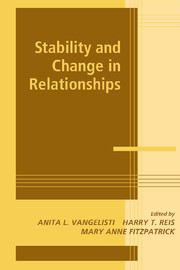Book contents
- Frontmatter
- Contents
- Contributors
- Preface
- PART ONE ACTORS: THE SCAFFOLDING OF STABILITY AND CHANGE
- 1 Change in Relationship Knowledge Representations
- 2 Personality Effects on Personal Relationships over the Life Span
- 3 An Intergenerational Model of Romantic Relationship Development
- 4 How Relationships Begin and End: A Genetic Perspective
- PART TWO BEHAVIORS: THE PROCESSES OF STABILITY AND CHANGE
- PART THREE CONTEXTS: SOCIAL ENVIRONMENTS FOR STABILITY AND CHANGE
- Author Index
- Subject Index
4 - How Relationships Begin and End: A Genetic Perspective
Published online by Cambridge University Press: 21 October 2009
- Frontmatter
- Contents
- Contributors
- Preface
- PART ONE ACTORS: THE SCAFFOLDING OF STABILITY AND CHANGE
- 1 Change in Relationship Knowledge Representations
- 2 Personality Effects on Personal Relationships over the Life Span
- 3 An Intergenerational Model of Romantic Relationship Development
- 4 How Relationships Begin and End: A Genetic Perspective
- PART TWO BEHAVIORS: THE PROCESSES OF STABILITY AND CHANGE
- PART THREE CONTEXTS: SOCIAL ENVIRONMENTS FOR STABILITY AND CHANGE
- Author Index
- Subject Index
Summary
In modern societies around the world, most romantic relationships begin when two people meet and fall in love. Authorities (e.g., Walster & Walster, 1978), as well as most long-married couples, agree that the affection between mated partners occurs in two forms: romantic love, which normally comes first and then, if all goes well, is followed by the even stronger bond of companionate love and commitment. The initial or infatuation stage often starts surprisingly soon after the first meeting. When the infatuation is mutual, as it must usually be for a relationship to ensue, it is characterized both by delight and by a sense of wonderment. “Is it not remarkable that the one person I was meant to love has crossed my path and, more wonderful still, that my lover loves me too?” Romantic love blossoms early but, like the rose, it also in most cases languishes and dies too soon. The world over, for example, the modal period between marriage and divorce, if divorce occurs, is about four years (Fisher, 1991). In those relationships that last, however, infatuation's span is sufficient to permit the maturation of companionate love, a slower growing but much more enduring plant, which is based on shared experiences and shared investments and on a gradual intertwining of habit patterns, needs, and understandings.
- Type
- Chapter
- Information
- Stability and Change in Relationships , pp. 83 - 102Publisher: Cambridge University PressPrint publication year: 2002
- 3
- Cited by



